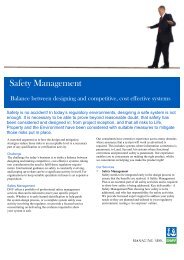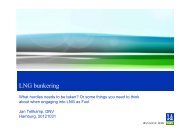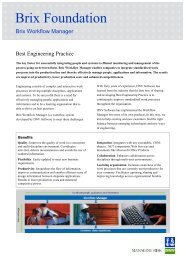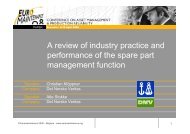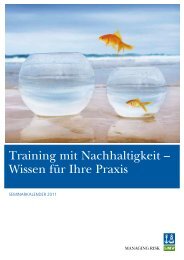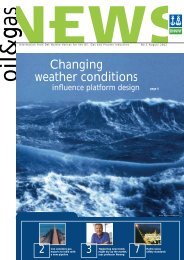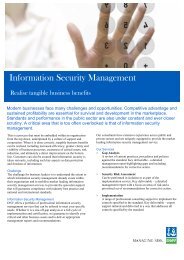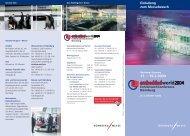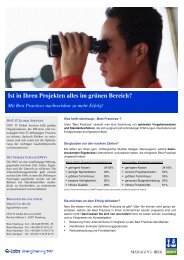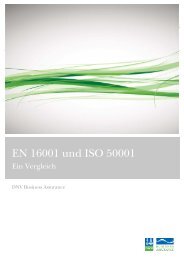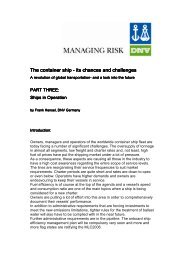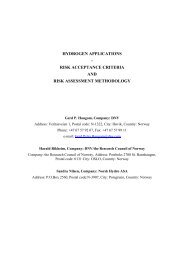First RBI study - DNV Germany
First RBI study - DNV Germany
First RBI study - DNV Germany
You also want an ePaper? Increase the reach of your titles
YUMPU automatically turns print PDFs into web optimized ePapers that Google loves.
oil&gas g<br />
Photo courtesy EVC, UK<br />
Information from Det Norske Veritas for the Oil, Gas and Process Industries No.3 June 2001<br />
2<br />
New EU requirements<br />
affecting third-party<br />
activities all over<br />
Europe<br />
4 6 <strong>First</strong><br />
Loss control<br />
management for<br />
Slovak Gas Company<br />
EVC moves from<br />
Compliance to<br />
Commitment<br />
see page 3<br />
<strong>RBI</strong> <strong>study</strong><br />
on a plant under<br />
construction
Industries face<br />
a complex<br />
balancing act<br />
The process industry is facing a complex balancing<br />
act to improve the safety of asset operations<br />
while maximizing production at reduced<br />
operating costs.<br />
The industry has for several years been characterised<br />
by restructuring and realignments, a trend<br />
that is expected to continue. An integrated<br />
approach is considered fundamental to achieving<br />
optimal performance.<br />
<strong>DNV</strong> has a track record in assisting customers<br />
to increase uptime while improving safety.<br />
We have developed a risk-based inspection (<strong>RBI</strong>)<br />
methodology that has become a world standard<br />
and is now one of several services aimed at<br />
improving asset operations of refineries and<br />
petrochemical industry. In all these services,<br />
efforts focus on high-risk units while eliminating<br />
low-value work.<br />
Companies that have successfully implemented<br />
<strong>RBI</strong> and RCM (reliability centred maintenance)<br />
programmes have reported direct savings in<br />
inspection and maintenance costs of up to<br />
USD100 million annually, along with increased<br />
reliability.<br />
This issue of Oil & Gas News addresses some<br />
recent asset-operation improvement projects and<br />
a European joint-industry project that aims at<br />
sharing risk-based maintenance and inspection<br />
approaches across different industrial sectors.<br />
Maarten Tichler<br />
Manager Oil Gas and Process Industries<br />
Region Western Europe<br />
2 Oil & Gas News 3 – 2001<br />
<strong>DNV</strong> engineer performing inspection and pressure testing<br />
of a piping system at a chemical plant in Sweden.<br />
Ensuring optimal performance<br />
in petrochemical industry<br />
<strong>DNV</strong> works closely with Swedish petrochemical plants such as<br />
Shell, Preem, Scanraff, Borealis and Akzo Nobel. Inspection engi-<br />
neers from <strong>DNV</strong> execute services in facilitation, inspection and<br />
modification of the production plant.<br />
Daily operation<br />
One to four engineers from <strong>DNV</strong><br />
provide daily services, consisting of<br />
recurring inspection of pressure vessels,<br />
piping, storage tanks and other items.<br />
When changes and repairs are done<br />
<strong>DNV</strong> performs review of piping and<br />
instrumentation diagrams, modification<br />
inspections etc. according to the Swedish<br />
regulations for pressure vessels and pressure<br />
retaining devices.<br />
New EU requirements<br />
Shutdown<br />
At shutdown and in new projects <strong>DNV</strong><br />
employs experienced inspection engineers<br />
and other experts in order to keep<br />
the shut-down time as short as possible.<br />
The number of engineers needed varies<br />
from 5-50 depending on the extent and<br />
complexity of the shutdown.<br />
The European pressure equipment directive, 97/23/EU–PED, is affecting national<br />
regulations for third-party activities all over Europe.<br />
In Sweden the ordinance for pressure vessels was changed from one to two publications<br />
in 1999. Three new publications will supersede one of these in May 2002 when<br />
PED and CE–marking are the only way for design review and manufacturing inspection<br />
of pressure equipment. They will cover the following areas:<br />
• Manufacturing of pressure equipment not covered by PED<br />
• Inspection of Pressure Equipment<br />
• Use of Pressure Equipment.<br />
The changes will affect <strong>DNV</strong> and Swedish industry in many ways. <strong>DNV</strong> will cooperate<br />
widely with the industry to meet the new regulations. Courses and further information<br />
will be offered to all customers in Sweden.<br />
The new requirements will come into force in 2002.<br />
Charlotta.Pedersen@dnv.com
For many companies, the manage-<br />
ment system is a document sitting<br />
unused on the shelf. Experience<br />
shows that lack of management<br />
system implementation is a major<br />
problem for organisations trying to<br />
improve their safety, health and envi-<br />
ronmental (SHE) performance. A new<br />
mind-mapping technique might be<br />
part of the solution.<br />
Moving from<br />
Compliance to Commitment<br />
‘We needed a new approach to move<br />
beyond ISRS (International Safety Rating<br />
System) compliance and implement the<br />
customised management system developed<br />
with <strong>DNV</strong>,’ says Nigel Waghorn,<br />
UK SHE manager in EVC (European<br />
Vinyls Corporation). ‘The next step was<br />
to translate the SHE standards into<br />
action.’<br />
EVC is Europe’s leading PVC (Polyvinyl<br />
Chloride) producer. By joining forces<br />
‘We needed a new approach to move<br />
beyond ISRS compliance,’ says Nigel<br />
Waghorn, UK SHE manager in EVC.<br />
Mind-Mapping Technique<br />
The mind-mapping technique pioneered with EVC is<br />
designed to improve management system implementation.<br />
It is based on three principles:<br />
• SHE activities must be integrated into primary tasks of managing<br />
the business if they are to be effective.<br />
• Individual task responsibilities for SHE management must<br />
be clearly defined, communicated and followed up for all<br />
job roles in the organisation if they are to be carried out.<br />
with <strong>DNV</strong> they have developed a new<br />
mind-mapping technique linking people<br />
and activities into individual action<br />
plans. In this way they believe the implementation<br />
phase will contribute to more<br />
commitment by the whole organisation.<br />
‘We are in the initial phase of adopting<br />
the new system and will need a period of<br />
time before we can say it is self-containing,’<br />
says Waghorn. ‘However, the<br />
process so far has proved to be very positive<br />
as it has enabled us to see how all our<br />
activities are related to each other. It contributes<br />
to increasing the information<br />
flow between people and departments.’<br />
EVC is implementing the system into<br />
their operational departments. Waghorn<br />
believes the new technique can be used<br />
in other departments such as finance and<br />
human resources. However, for the system<br />
to prove efficient, it depends on how<br />
the organisation manages to establish the<br />
links between the various activities. For<br />
example, the training system must<br />
address appropriate emergency training<br />
needs before any emergency plans can<br />
be implemented.<br />
The new technique is being implemented<br />
at EVC’s four sites in the UK. As<br />
soon as the initial phase is completed,<br />
implementation in other EU sites will be<br />
considered.<br />
Beate.V.Orbeck@dnv.com<br />
• Management systems are typically described in separate<br />
elements although in reality they are highly inter-linked.<br />
The interdependencies between elements must be<br />
described and planned for so that the necessary information<br />
flows between activities.<br />
For more information contact:<br />
Chris.Urwin@dnv.com<br />
Geoff.Farnell@dnv.com<br />
EUROPE<br />
The VC3 plant at Runcorn, Chesire, UK<br />
EVC (European Vinyls<br />
Corporation):<br />
• Leading producer of PVC<br />
(Polyvinyl Chloride) in Europe<br />
• Ineos Capital Limited owns over<br />
68% of the shares<br />
• 8 sites located in UK, Italy and<br />
<strong>Germany</strong><br />
• PVC production is used in<br />
the building and construction<br />
sector, and packing, leisure and<br />
transport industries.<br />
Oil & Gas News 3 – 2001 3<br />
Photo courtesy EVC, UK
<strong>DNV</strong> was awarded a four-year contract to<br />
help SPP establish the management system.<br />
The project is headed by <strong>DNV</strong>`s<br />
local staff in Slovakia supported by an<br />
international team of experts from the<br />
UK, <strong>Germany</strong>, Norway and the Czech<br />
Republic. The scope of work is based on<br />
an integrated loss control management<br />
system including several modules (see<br />
fact box).<br />
Scope<br />
The project started with a high level<br />
review to analyse the situation and to set<br />
4 Oil & Gas News 3 – 2001<br />
EUROPE<br />
Loss Control Management<br />
for Slovak Gas Company<br />
It is the first time the contractor, Linde<br />
Engineering and Contracting in<br />
<strong>Germany</strong>, has made use of risk calculations<br />
in the layout concept instead of<br />
using only engineering standards. A consortium<br />
comprising Statoil, TotalFinaElf<br />
and Gaz de France will own the LNG<br />
plant.<br />
One of the challenges facing the <strong>DNV</strong><br />
engineers was the requirement to per-<br />
The Slovak Gas Company (SPP) decided in 1999 to establish an effective<br />
management system by making use of loss control management princi-<br />
ples. SPP is the principal provider of Russian gas to the European market.<br />
up priorities for the<br />
project. Four pilots were<br />
selected for two compressor<br />
stations covering environment<br />
and safety, subsidiary<br />
lines for environment<br />
and such services as maintenance and<br />
non-destructive control of the environment.<br />
Three pilots were chosen from the<br />
distribution division focusing on quality,<br />
subsidiaries for distribution and producing<br />
regulation stations and a distribution<br />
subsidiary for the environment. Specific<br />
goals were set up to prepare for the final<br />
certification.<br />
Main distributor<br />
SPP is the principal provider of Russian<br />
gas transportation through Slovak territory<br />
to Western Europe, with approxi-<br />
mately 80% of Russian gas deliveries. The<br />
transition system consists of four lines<br />
and in some areas a fifth line, in addition<br />
to four compressor stations. SPP is<br />
preparing for privatisation during 2001.<br />
49% of the shares will be sold to foreign<br />
owners.<br />
Juraj.Kramara@dnv.com<br />
<strong>DNV</strong> is developing risk-engineering expertise in the fast-growing<br />
LNG (liquefied natural gas) market. A new LNG plant to be built in<br />
the north of Norway has been subjected to extensive risk analyses<br />
by <strong>DNV</strong> expertise from Belgium.<br />
form an extensive escalation analysis for<br />
a fire and fragmentation explosion.<br />
Based on the results of this analysis, the<br />
plant-layout design was refined to meet<br />
Statoil`s safety requirements.<br />
A taskforce of five engineers has been<br />
responsible for these studies, which<br />
involved Hazops in different stages of the<br />
project, calculating safety distances,<br />
developing a safe layout for the facility<br />
Modules used for<br />
the integrated loss control<br />
management system:<br />
• Quality (IQRS)<br />
• Environment (IERS)<br />
• Safety (ISRS)<br />
• Contractor safety (ICCS)<br />
• Operational Risk Management<br />
Introductory Study<br />
• Human Resource Management<br />
• IT support<br />
Risk <strong>study</strong> in<br />
fast-growing LNG market<br />
Risk contours for LNG<br />
production facility<br />
and conducting a full quantitative risk<br />
analysis.<br />
This project is one of several similar projects<br />
in which <strong>DNV</strong> is engaged in risk<br />
studies for LNG plants and terminals<br />
worldwide.<br />
Dirk.Roosendans@dnv.com
Kerteh Industrial Estate is one of the<br />
largest industrial sites in Malaysia with<br />
more than 25 plants on site.<br />
The main objective of the IRA was to<br />
perform an overall assessment of major<br />
hazards that could affect personnel,<br />
assets, productivity and impact on the<br />
environment. Special consideration was<br />
given to the complexity related to knockon<br />
effects from one site to another, and<br />
inter-dependencies of process and utilities<br />
streams. The site comprises power<br />
stations, refinery, petrochemical complexes,<br />
and oil receiving terminal.<br />
Inserting risk picture<br />
<strong>DNV</strong> was selected to undertake the <strong>study</strong>.<br />
The main tool utilised for the toxic and<br />
flammable risk modeling was Safeti. The<br />
advantage of using Safeti is that risk<br />
results are easily inserted in the geo-<br />
graphical map of the area. The model<br />
can be updated to account for new<br />
hazards, new population or any design<br />
modification on existing plants. For business<br />
disruptions spreadsheet models<br />
were developed.<br />
Optimised locations<br />
The <strong>DNV</strong> <strong>study</strong> has been used to propose<br />
relocation of new infrastructure such as<br />
residential areas, public roads and nonindustrial<br />
activities as appropriate. It has<br />
been applied to optimise locations of<br />
control rooms and administration buildings<br />
by taking into account potential<br />
hazard distances from toxic and flammable<br />
events.<br />
The inter-dependency evaluation between<br />
ASIA<br />
Kerteh Industry<br />
goes for<br />
risk assessment<br />
The first integrated risk assessment (IRA) <strong>study</strong> has been successfully completed<br />
in Malaysia. The country’s growing economic dependence on the petrochemi-<br />
cal industry has required Petronas to commission an IRA <strong>study</strong> for the Kerteh<br />
Industrial Estate.<br />
various plants has been used to identify<br />
required back-up supplies and export<br />
abilities, in order to minimise any<br />
business disruption in case of major<br />
accidents.<br />
Optimised emergency plans<br />
Petronas is currently using the results of<br />
the <strong>study</strong> to review and optimise the<br />
common emergency response plan for<br />
the area. Special emphasis is being given<br />
to issues such as medical facility requirements,<br />
alarm warning procedures and<br />
evacuation requirements.<br />
Kjell.Are.Vassmyr@dnv.com<br />
Breakthrough for <strong>RBI</strong> Services<br />
in Indonesia The demand for <strong>DNV</strong>’s risk based inspections (<strong>RBI</strong>) and other risk-<br />
Pertamina, the sole oil-refinery operator in<br />
Indonesia, is the first company in the country to sign<br />
a contract with <strong>DNV</strong> to purchase the software package<br />
tool O<strong>RBI</strong>T Onshore. In addition <strong>DNV</strong> will run<br />
a series of <strong>RBI</strong> training courses and establish consulting<br />
services for all Pertamina’s seven refineries.<br />
management services is increasing in Indonesia, due to several unexpect-<br />
ed events in petrochemical plants and refineries leading to shutdowns.<br />
The first <strong>RBI</strong> consulting project has been completed<br />
at Pangkalan Brandan refinery, while work at the<br />
Balikpapan and Cilacap refineries is just about to<br />
start.<br />
Haris.Ranuamihardjo@dnv.com<br />
Oil & Gas News 3 – 2001 5
NORTH AND SOUTH AMERICAS<br />
<strong>First</strong> <strong>RBI</strong> <strong>study</strong> performed<br />
on a plant under construction<br />
<strong>DNV</strong> has completed the first risk-based inspection (<strong>RBI</strong>) <strong>study</strong> ever performed on<br />
a plant under construction, the SINCOR C.A. Upgrader Refinery in Venezuela.<br />
The objective of this project was to assist<br />
SINCOR C.A. in optimizing its inspection<br />
plans and strategy for the process<br />
pressure vessels and piping before startup,<br />
and to train its staff to manage its<br />
inspection programme using <strong>RBI</strong>.<br />
Forecasting risk<br />
The <strong>RBI</strong> inspection planning process<br />
included a forecast of the risks up to the<br />
year 2010 in order to determine the minimum<br />
inspection requirements for the<br />
2006 turnaround. The idea is that any<br />
equipment showing a risk by the 2010<br />
turnaround that is larger than the<br />
acceptable risk agreed by Sincor personnel,<br />
should be inspected in the 2006<br />
turnaround.<br />
Baseline inspection<br />
Because the upgrader-type refinery is<br />
new, there was no inspection history<br />
that could be fed into the <strong>RBI</strong> software<br />
to determine inspection intervals. To<br />
remove any uncertainties and increase<br />
conservatism, Sincor and <strong>DNV</strong> personnel<br />
agreed on criteria for a baseline inspection.<br />
This was decided to obtain initial<br />
corrosion rates and cracking susceptibilities<br />
that would confirm the engineering<br />
assumptions used for the <strong>study</strong>.<br />
6 Oil & Gas News 3 – 2001<br />
Knowing their boundaries<br />
Maximum and minimum limits were also<br />
identified for each of the operational<br />
variables that drive the identified corrosion<br />
mechanisms. Depending on the<br />
damage mechanisms, these variables<br />
included pH values, temperature, percentage<br />
of ammonium bisulphate,<br />
amine concentrations, fluid velocity, etc.<br />
Identification of these variables will allow<br />
plant operators to know their boundaries<br />
and inform the inspection group when<br />
they have exceeded these and for how<br />
long.<br />
Armed with this information, inspectors<br />
will be better able to predict where a corrosion-damage<br />
mechanism might be<br />
developing.<br />
Benefits<br />
Once the inspection plans had been<br />
reviewed and approved, they were<br />
compared with an inspection plan<br />
developed without <strong>RBI</strong>. The savings<br />
from using <strong>RBI</strong> over the next four years<br />
were estimated to be USD 4.54 million<br />
for a ROI of 32 to 1.<br />
For more information, contact:<br />
Ricardo.Valbuena@dnv.com<br />
‘With <strong>RBI</strong>, plants under construction are<br />
able to identify where the risks are and<br />
develop inspection plans to manage the<br />
risks all from the start of their operations,’<br />
says Ricardo Valbuena <strong>DNV</strong> Houston.<br />
SINCOR is a joint venture<br />
between PDVSA, Statoil and<br />
TotalFinaElf.<br />
It will transform very heavy sour<br />
crude oil from the Orinoco Basin<br />
into a lighter sweet crude for sale<br />
to more typical gasoline-producing<br />
refineries.<br />
Camaçari improves safety management<br />
Camaçari petrochemical<br />
complex, Brazil<br />
The Camaçari petrochemical complex, one of the biggest and most<br />
important in Brazil, has commissioned <strong>DNV</strong> to perform risk assessments at<br />
52 companies operating in the industrial complex.<br />
‘This project will bring a significant improvement in safety management to<br />
the Camaçari complex’, says Luiz Fernado Garcia Lampeiro, Polibrasil’s<br />
superintendent in Camaçari.<br />
Embracing all 52 companies within the Camaçari complex, the project<br />
schedule is 30 months with an investment of USD 1.5 Million. The project<br />
comprises training of personnel, identification, mapping and assessment of<br />
hazards, risk assessments, recommendation of mitigation measures and the<br />
implementation of risk management and reduction programmes in all companies<br />
involved.<br />
Jose.Pontes@dnv.com
Risk-based approach<br />
to pipelines in North America<br />
As a result of several fatal explosions in<br />
pipelines lately, the U.S. Department of<br />
Transportation issued a final rule requiring<br />
hazardous-liquid, including crudeoil,<br />
pipelines with over 500 line miles to<br />
complete integrity management plans,<br />
including risk assessment, by 31 March<br />
2002. Operators must identify all highconsequence<br />
areas by 31 December<br />
2001.<br />
High Consequence Areas<br />
Under 49 CFR 195.452, pipeline operators<br />
must identify all segments of their<br />
pipes that travel through High<br />
Consequence Areas (HCA). HCAs contain<br />
any or all of the following sensitive<br />
AUSTRALIA<br />
NORTH AND SOUTH AMERICAS<br />
New pipeline regulations require integrity-management systems and risk assess-<br />
ment for hazardous liquid pipelines over 500 miles. <strong>DNV</strong> is performing the first<br />
environmental risk assessment under the new scheme on a new pipeline project<br />
in the U.S. Gulf of Mexico.<br />
receptors: high population areas, other<br />
population areas, commercially navigable<br />
waterways, and unusually sensitive<br />
areas. Once the HCAs have been identified,<br />
the operator must conduct a risk<br />
assessment of its pipeline going through<br />
the area. Operators must also demonstrate<br />
they have an integrity management<br />
system in place to ensure that pipeline<br />
failure risks are minimized.<br />
<strong>DNV</strong> supported the American Petroleum<br />
Institute in the development of the guidance<br />
document for industry (API 1160)<br />
on pipeline integrity management and<br />
risk assessment.<br />
The regulations are likely to be extended<br />
to gas pipelines in the coming year. With<br />
<strong>DNV</strong>’s solid background in both integrity<br />
management and risk assessment, we<br />
look forward to working with both liquid<br />
and gas pipeline companies in the<br />
future.<br />
For further information regarding<br />
pipeline integrity management programs<br />
at <strong>DNV</strong>, please contact Mark Boult at<br />
+1 281-721-6846.<br />
Mark.Boult@dnv.com<br />
Michelle.Kareis@dnv.com<br />
Victoria complies with new<br />
Major Hazard Regulations<br />
<strong>DNV</strong> is developing pilot safety cases with several process-<br />
industry clients in Victoria, Australia to help them comply<br />
with the new major hazard-facility regulations.<br />
The new regulations require operators<br />
to demonstrate the adequacy of their<br />
controls and safety-management systems<br />
by means of a comprehensive safety case.<br />
<strong>DNV</strong> is preparing pilot safety cases with<br />
companies such as Qenos, Australian<br />
Vinyls, Dow and Orica.<br />
Teams of plant operators, engineers,<br />
maintenance staff and <strong>DNV</strong> specialists<br />
are working together to prepare pilot<br />
safety cases for specific parts of each<br />
facility, and to extend the methods to<br />
other parts of the site and other facilities.<br />
The objective is to exploit existing safety<br />
knowledge and tools while at the same<br />
time challenging the operator’s current<br />
understanding of risk and the way it is<br />
managed.<br />
This approach enables all required skills<br />
and expertise to be incorporated into the<br />
process, providing robust results and a<br />
tested method that can be applied to the<br />
rest of the business. It is highly attractive<br />
to operators of large, complex or<br />
multiple facilities, where corporate,<br />
economic and time constraints demand<br />
that safety cases are produced efficiently<br />
and consistently while ensuring that local<br />
experience of the process is reflected in<br />
the results.<br />
Huw.Jones@dnv.com<br />
Oil & Gas News 3 – 2001 7
16 organisations from eight European countries are represented in the EU-<br />
funded Research and Technology Development project RIMAP. The project<br />
is part of <strong>DNV</strong>'s strategic research programme “Energy and Resources”.<br />
The overall goal of the project is to<br />
develop a unified approach to make riskbased<br />
decisions in the field of maintenance<br />
and inspection. This is particularly<br />
important for pressure equipment when<br />
the new Pressure Equipment Directive<br />
PED comes into force in 2002. The present<br />
PED does not address the in-service<br />
phase, only the design phase.<br />
The Swedish authorities have issued new regulations to ensure<br />
the safe operation of nuclear power plants. These include permission<br />
to use quantitative risk-based methods to select the sites<br />
that are to be inspected and to determine appropriate inspection<br />
intervals.<br />
The new software package is called NU<strong>RBI</strong>T (Nuclear <strong>RBI</strong><br />
Analysis Tool). The aim is to develop a software system that<br />
enables quick and cost-effective procedures for evaluating risks<br />
and costs in nuclear piping systems. The system’s central<br />
parameter is to evaluate the risk of core damage if the core<br />
should melt and the possible subsequent release of fission products<br />
to the environment.<br />
<strong>DNV</strong> is developing software and a cost-optimisation module.<br />
The project is scheduled for completion in December 2001.<br />
Bjorn.Brickstad@dnv.com<br />
<strong>DNV</strong> services to the oil,<br />
gas and process industries<br />
We are helping clients within the<br />
following service areas:<br />
• Safety, health and environment<br />
• Qualification and innovation<br />
• Verification and<br />
classification<br />
• Asset operations<br />
For further information,<br />
see www.dnv.com/ogpi<br />
8 Oil & Gas News 3 – 2001<br />
EUROPE<br />
European project on risk-based<br />
maintenance and inspection planning<br />
The main deliverables from the work<br />
will be:<br />
• A method describing a unified<br />
approach to maintenance and inspection<br />
planning based on risk-decision<br />
criteria and cost optimisation<br />
• Documented validation and testing of<br />
the method within the industry sectors<br />
represented in the project<br />
Published by Corporate<br />
Communications<br />
Editor: Beate V. Ørbeck<br />
Layout: <strong>DNV</strong> Graphic<br />
Communications<br />
Print: GAN Grafisk AS<br />
• Guidelines for practical use in the<br />
format of “workbooks” per industry<br />
sector<br />
• A technical framework for a European<br />
standard for inspection and maintenance<br />
planning.<br />
Related links:<br />
http://research.dnv.com/rimap<br />
Gjermund.Vage@dnv.com<br />
New risk-based software for nuclear plants<br />
The Swedish authorities and nuclear power plants are co-operating with<br />
<strong>DNV</strong> in developing a new risk-based software tool for the nuclear industry.<br />
Det Norske Veritas (<strong>DNV</strong>) is an autonomous, independent Foundation with the objective of safeguarding<br />
life, property and the environment. The <strong>DNV</strong> organisation comprises 300 offices in 100 countries, with<br />
a total of 5,500 employees.<br />
Oil & Gas News<br />
is a newsletter published by Det<br />
Norske Veritas, Business Area Oil,<br />
Gas and Process Industries.<br />
It is distributed to <strong>DNV</strong> customers<br />
and stations worldwide. It is also<br />
available at <strong>DNV</strong>’s web site.<br />
Please direct any enquiries to your<br />
nearest <strong>DNV</strong> station, or Oil & Gas<br />
News e-mail:<br />
oil&gas.news@dnv.com<br />
Oskarshamn nuclear plant in Sweden.<br />
DET NORSKE VERITAS<br />
Head Office Norway<br />
Veritasveien 1,<br />
N-1322 Høvik, Norway<br />
Tel: +47 67 57 99 00<br />
Fax: +47 67 57 99 11<br />
Updated list of all regional<br />
offices at <strong>DNV</strong>’s web site:<br />
www.dnv.com<br />
5000/06/2001 Printed by GAN Grafisk Design by Det Norske Veritas Eiendom AS 0105-031




